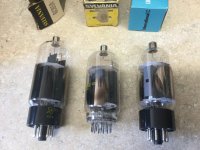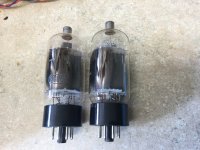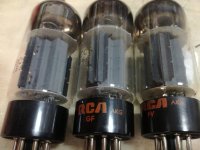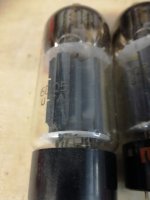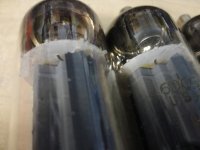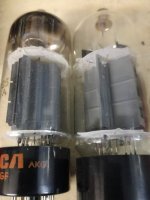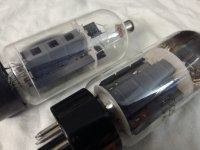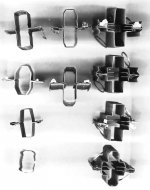I couldn't find the data for the 25HX5 tubes anywhere, so please have someone post them, or post a link to the source where they can be found.
The manufacturer's data for E235L tubes are very confusing and different, so the maximum allowed permanent anode dissipation is according to SIEMENS Pa = 12W, PHILIPS Pa = 16W, and TELEFUNKEN Pa = 20W. I’ve made a few amps with the E235L, and I have a few dozen new ones so I’ve spent a lot of time experimenting with how much I can really load. Experiments and practice through many years of operation of the amplifier have shown that it is a very durable tube that easily withstands anode dissipation greater than 20W without shortening the service life and degrading the characteristics. If the 25HX5 is more or less a copy of the E235L (apart from the voltage and heating current, of course), it is a very interesting tube.
There's the E236L also, same tube but with plate top cap. Besides it's plate dissipation rating quite similar to a plain EL36.
Best regards!
Best regards!
E235L, EL36, EL360 and PL36 have identical plate shape and size, but differ in some details in the internal construction. The E235 has increased G2 cooling at the top and additional stiffening (a small “frame grid”), and the EL360 has ceramic brackets and insulators that hold the plates. The EL36 and PL36 versions of the "Mullard" company are mechanically completely identical, as well as the E235L versions of the "Siemens" and "Philips" companies, where only the code shows that they were not produced in the same factory.
Attachments
-
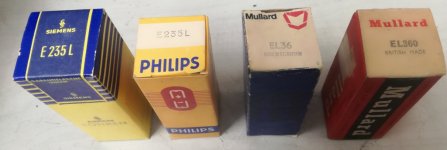 E235L-s E235-p EL36-m EL360-m.jpg236.4 KB · Views: 340
E235L-s E235-p EL36-m EL360-m.jpg236.4 KB · Views: 340 -
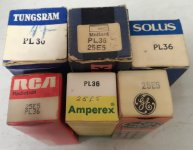 EL36-25e5.jpg440.6 KB · Views: 329
EL36-25e5.jpg440.6 KB · Views: 329 -
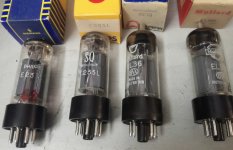 E235-s E235-p EL36 EL360 tubes.jpg456.5 KB · Views: 344
E235-s E235-p EL36 EL360 tubes.jpg456.5 KB · Views: 344 -
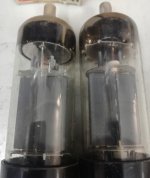 EL36 EL360 plate size.jpg281.1 KB · Views: 312
EL36 EL360 plate size.jpg281.1 KB · Views: 312 -
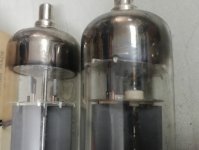 EL36-EL360-dif..jpg416 KB · Views: 297
EL36-EL360-dif..jpg416 KB · Views: 297 -
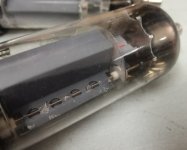 EL36-mull-plate.jpg401.9 KB · Views: 181
EL36-mull-plate.jpg401.9 KB · Views: 181 -
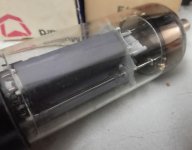 EL360-mull-plate.jpg388.4 KB · Views: 177
EL360-mull-plate.jpg388.4 KB · Views: 177 -
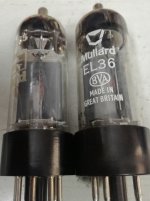 PL36 EL36 mull.jpg267.2 KB · Views: 190
PL36 EL36 mull.jpg267.2 KB · Views: 190
“Made in Gt. Britain”, hmmmm.....
I wonder who actually made those 26DQ5’s (on the right). They say “Made in Gt Britain” on them, but don’t look Mullard-esque to me. I have a couple that say Japan and look identical. The construction is very nice, and they don’t rattle when thumped nearly as bad as GE or Sylvania sweeps do. But they are just generic TV service replacements from “International Components”, which could be any number of sources. Anyone have ideas as to who? The other two are very obvious Sylvania tubes of other similar types.
I wonder who actually made those 26DQ5’s (on the right). They say “Made in Gt Britain” on them, but don’t look Mullard-esque to me. I have a couple that say Japan and look identical. The construction is very nice, and they don’t rattle when thumped nearly as bad as GE or Sylvania sweeps do. But they are just generic TV service replacements from “International Components”, which could be any number of sources. Anyone have ideas as to who? The other two are very obvious Sylvania tubes of other similar types.
Attachments
I made a small amp with PL 36 trioded, a homemade OPT that was meant for 45, when I turned up the supply to max, 380 V or so, the PL36 got 20 watt and in the dark some glow was visible. Music was nice, 4 or 5 Watt.
I have a Westinghouse 26DQ5 here which says JAPANF5 under the type print. Maybe the F5 indicates which manufacturer. I've seen some pretty good tubes made by Matsushita, Toshiba and Panasonic.
Some International marked tubes just have white paint on them for the type # which rubs off easily. I'm a little leery of those ones.
------------------------------------
One difference I've seen between EL36 and E235L is the max voltage ratings.
EL36 250V/250V and E235L 400V/300V,
25HX5 has the latter 400V/300V.
The Sylvania made in USA 25HX5 I have use black plates, while the GE and the National 25HX5 say JAPAN and have grey plates.
Some International marked tubes just have white paint on them for the type # which rubs off easily. I'm a little leery of those ones.
------------------------------------
One difference I've seen between EL36 and E235L is the max voltage ratings.
EL36 250V/250V and E235L 400V/300V,
25HX5 has the latter 400V/300V.
The Sylvania made in USA 25HX5 I have use black plates, while the GE and the National 25HX5 say JAPAN and have grey plates.
Last edited:
Although I can't say that 100%, an optical examination with a magnification of ~ 6x shows that the wire from which the G2 tube E235L is wound is different from the one from EL36, at least from the ones I had the opportunity to take out of the glass balloon. When testing the E235L, I tested the triode connection up to Ub ~ 400V (Neuberger RPM370 / 1) and did not notice any traces of redness even in complete darkness until the dissipation of Pa + Pg2 ~ 22W, exactly as stated in the data of the company TELEFUNKEN. I noticed a similar behavior with the EL360 tube (up to Ua + Ug2 ~ 370V and Pa + Pg2 ~ 20W), but with the EL36 tube in the triode junction, traces of redness started to appear from ~ 330V-350V (different from manufacturer to manufacturer, and maybe depending on the state of the vacuum !?). Probably the wires for G2 tubes E235L and EL360 are made of a different material (maybe gold-plated, can't be seen very well?), because there are no other design differences (winding step, gaps, wire and bracket thickness, etc.).
Last edited:
Oh, the Westinghouse/Japan 26DQ5 tubes I have, have cooler fins up top for grid 2. I don't see them obvious on the pictured tube in the post # 1347 International 26DQ5.
Last edited:
I purchased a big lot of bulk packed 6KT6's. All came in 100 unit boxes with oriental printing. 400 of them have 6KT6 and GT BRITAIN screened on top half of them in easy to rub off white paint. One identical looking box has 6KT6 in a medium font followed by 900 in a smaller font screened on the lower half in a dark color that requires a pencil eraser to remove. All have identical construction and a seam line in the glass.
I sold a bunch of 13GB5's to Stan at ESRC several years ago. Most were Of UK origin, and had Mullard etched codes. A few were different, and Stan did not want them because they were "Korean." They had the same look and paint as these 6KT6's. They were in International Servicemaster boxes, while the real Mullards all wore US brands. The Korean 13GB5's did have smaller guts than the Mullards and weighed less. No surprise that they red plated easier.
These 6KT6's work fine in all of my circuits, but they live an easy life on about 175 volts at less than 10 mA.
I sold a bunch of 13GB5's to Stan at ESRC several years ago. Most were Of UK origin, and had Mullard etched codes. A few were different, and Stan did not want them because they were "Korean." They had the same look and paint as these 6KT6's. They were in International Servicemaster boxes, while the real Mullards all wore US brands. The Korean 13GB5's did have smaller guts than the Mullards and weighed less. No surprise that they red plated easier.
These 6KT6's work fine in all of my circuits, but they live an easy life on about 175 volts at less than 10 mA.
Some USA-made 6DQ5 RCA tubes have welded additional sheets on the sides that increase the surface area of the plate. I cannot assess whether such can be loaded with a higher load, or whether it is designed to extend service life under normal operating conditions. By measuring and testing on a tube tester (NEUBERGER-RPM 370/1) no difference can be seen compared to the usual 6DQ5 version from the same manufacturer.
The first three images show tubes with additional expansion at the anode, and the fourth and fifth are beside to the usual 6DQ5 version where can see differences.
The first three images show tubes with additional expansion at the anode, and the fourth and fifth are beside to the usual 6DQ5 version where can see differences.
Attachments
Yes, these extra "winglets" on the plate edges are fairly common on later USA TV Sweep tubes. They are a continuation of the internal "Barkhausen" plates used to suppress VHF oscillations. And also suppress secondary emission by means of grazing angle electron interception inside a small extended box (the small bulge on the side of the plate). This gives the tubes sharp "knees" (plate curves) and lowers grid 2 current.
This does tend to make for sharper saturation, so some don't like the sound of Barkhausen plates. But it also improves efficiency so more power is available. The soft pentode rounded knees like 6BQ5/EL84 seem to be preferred for lower power amps that will saturate, while the square knees are preferred with high power amps, where saturation would be rare and extended power is welcome.
6LG6 is an example:
This does tend to make for sharper saturation, so some don't like the sound of Barkhausen plates. But it also improves efficiency so more power is available. The soft pentode rounded knees like 6BQ5/EL84 seem to be preferred for lower power amps that will saturate, while the square knees are preferred with high power amps, where saturation would be rare and extended power is welcome.
6LG6 is an example:
Attachments
Last edited:
6DQ5 was an earlier TV Sweep design which did NOT have the plate "winglets" in it's original design.
I don't see any like that on Ebay either. I think what you have there are late production tubes (toward the end of tube production) which has 6LG6 guts put into it. The 6LG6 was just a 6DQ5 with the upgraded "winglet" plate. It would be interesting to do comparative curve tracings of the "winglet" version versus the non "winglet" 6DQ5 version, and also versus a 6LG6.
I don't see any like that on Ebay either. I think what you have there are late production tubes (toward the end of tube production) which has 6LG6 guts put into it. The 6LG6 was just a 6DQ5 with the upgraded "winglet" plate. It would be interesting to do comparative curve tracings of the "winglet" version versus the non "winglet" 6DQ5 version, and also versus a 6LG6.
Yes, the LG6 data sheet mentions the reduced “snivets”. The plate curves at low Ip and Vp don’t have any kink, but the ig2 curves do. Wouldn’t negative resistances here also potentially cause oscillations? Especially considering you would want to keep the screen stopper resistor pretty low (with regulated Vg2)?
You make a good point about negative resistance at the grid 2. (where screen current is dropping with lower plate V, at least it appears to be something like neg. R, would need to check versus screen V I guess ) Many TV Sweeps have this feature, not just the "winglet" plate versions. So a low impedance source at grid 2 would appear to be important for most all of them. Could maybe estimate the neg. R value from the datasheet, and make sure the grid 2 stopper R is below that.
Last edited:
-----
"6DQ5 was an earlier TV Sweep design which did NOT have the plate "winglets" in it's original design.
I don't see any like that on Ebay either. I think what you have there are late production tubes (toward the end of tube production) which has 6LG6 guts put into it. The 6LG6 was just a 6DQ5 with the upgraded "winglet" plate.[U] It would be interesting to do comparative curve tracings[/U] of the "winglet" version versus the non "winglet" 6DQ5 version, and also versus a 6LG6."
-----
I have ~ 80 or maybe more 6DQ5 from American manufacturers (RCA, Sylvania, DuMont, Philco, GE, etc.), and some ~ 30 of them are from RCA. Only 3 have these extra wings in RCA tubes. I do not have a "Curve tracer" but only a NEUBERGER-RPM370 / 1 tube meter on which I can statically measure the tubes and, if we so agree, send one or more of them to you.
"6DQ5 was an earlier TV Sweep design which did NOT have the plate "winglets" in it's original design.
I don't see any like that on Ebay either. I think what you have there are late production tubes (toward the end of tube production) which has 6LG6 guts put into it. The 6LG6 was just a 6DQ5 with the upgraded "winglet" plate.[U] It would be interesting to do comparative curve tracings[/U] of the "winglet" version versus the non "winglet" 6DQ5 version, and also versus a 6LG6."
-----
I have ~ 80 or maybe more 6DQ5 from American manufacturers (RCA, Sylvania, DuMont, Philco, GE, etc.), and some ~ 30 of them are from RCA. Only 3 have these extra wings in RCA tubes. I do not have a "Curve tracer" but only a NEUBERGER-RPM370 / 1 tube meter on which I can statically measure the tubes and, if we so agree, send one or more of them to you.
Last edited:
I would be happy to curve trace one of those "winged" 6DQ5 oddities. I have conventional RCA 6DQ5 tubes and 21LG6A tubes here already to compare with on the curve tracer.
- Home
- Amplifiers
- Tubes / Valves
- Those Magnificent Television Tubes
